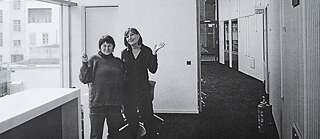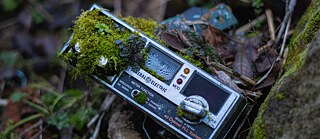Interview with Maraa Community Radio in India

How does radio manage to make us feel at home? How can radio help in crises situations? How is radio funded in India, and who invented it? Anushi Agrawal and Ram Bhat from the Bangalore art and media collective Maraa talk to Verena Hütter.
Ram: Maraa is a media arts collective. It’s a non-profit organisation. In the Indian state of Karnataka, the local language is Kannada. And in Kannada “Maraa” means “tree”. All of us at the organisation have an interest in media and a background in community radio. Starting in 2008, we set up some of the country’s first community radio stations. We trained the people who run the stations on topics such as research, programming, production, documentation and financial planning. We offered them different types of support and many of those stations are still broadcasting today
Radio connects us with our home.
Ram: I think in many ways, print is official. A language has to overcome a very high barrier to make it into print. It has to be a recognised language; there has to be a printing infrastructure around that language and a readership. There has to be a font and a script. Radio, on the other hand, is a spoken medium. We feel that community radio is really helpful in promoting languages that do not make the official language classification. In India, there are 26 languages that are recognised by the government. The many other languages and dialects are informal. It’s largely left to culture to sustain those languages. And I think radio is a very important part of that cultural work in that it ensures the language lives on, without necessarily trying to make it official in that sense. As languages evolve, there are new words, there are new ways of putting together new realities. So radio can help transcript that language as it is evolving.
Anushi: Many languages and dialects don’t have any script. But they are spoken. So radio is a really good platform for those kinds of languages because there is a lot of culture associated with them, lots of songs. They’re passed on from generation to generation. When people migrate for work, they leave their own land and go to a city. If the city has a radio programme in their language, it immediately connects them to their own land. For example, many workers migrate from Bihar state to Gurgaon city in search of work. There is a community radio station in Gurgaon which broadcasts music in the local language of Bihar state. Workers who have left their land and come far to work immediately connect with this music. The community radio station gets many calls requesting songs to be played in the local language of the workers.
I can absolutely see that. Whenever I hear a person speaking with an accent from the southern part of Germany that I come from, it gives me this special feeling; language feels like home. What about the community radio stations that you work with at Maraa – are different languages spoken at one station or is it one language per station?
Anushi: We work with a network of radio community stations which are spread across the country. They all broadcast in different languages. According to Indian law, community radio can only have a 20-kilometre broadcast radius. So the languages that are spoken in an area are represented by their local radio station. The radio programme is very focused on the population within its broadcasting range.
Ram: If it’s a rural radio station, the community in the footprint area of the radio is not very heterogeneous. It’s most likely going to be one dialect. But an urban radio station usually broadcasts in many languages. Because the audience is more diverse
Community radios in India get their funding from very different sources.
Ram: It’s a mixed model. According to law, community radios are allowed five to eight minutes of advertising for every hour of air time. These are mostly local advertisers, like a local shop or people who want to make private announcements about festivals. Another part of the funding is sponsoring. During the COVID pandemic, the health ministry sponsored a programme on vaccinations. The license for community radios is often obtained by a non-profit organisation, and the radio station is managed as part of the organisation’s larger budget. Those organisations focus on specific topics, like violence against women or environmental issues, and they get funding for that.
Anushi: There are also UN bodies like UNICEF and UNESCO that have supported programming at community radio stations in India. For example, UNESCO supported a network of 13 community radio stations in India to broadcast programmes on issues related to the COVID pandemic in collaboration with Maraa.
What about national public radio in India? In Germany, national public radio and television is funded via a public licence fee. How does it work in India?
Ram: It’s tax payers’ money, but it’s not a license fee like in Europe. Basically, it’s government funds, and some of this is given to public broadcasters. The public broadcaster is an independent, autonomous organisation. But the government controls the public broadcaster through the funding, the budget and the appointment of an official at the highest position to manage it all. So you see, in practice, it’s not very independent
It’s very easy to set up a radio station.
Ram: Whether it’s a man-made conflict or a natural crisis, there is an increased demand for communication. People are worried about what’s happening. They want contact, so the communication infrastructure comes under considerable pressure. The telecommunication infrastructure breaks down very easily because of this increase in traffic, or because there’s no electricity. Radio can be a very reliable back-up. The existing radio infrastructure may break down, but new radio infrastructure can be set up overnight. It’s very easy to set up a temporary radio station.
I’m part of a regional network of community radio broadcasters called AMARC. The people there have developed a technique that can be used to quickly set up a radio station with minimal equipment. They call it “radio in a suitcase” or “radio in a backpack”. That was used in Nepal when the earthquake struck, or in the western part of Indonesia, when there were volcanic eruptions.
Do you know about the early days of radio in India? I read in Wikipedia that it was the British who started radio in India, is that right?
Ram: The British institutionalised the radio in India. Before that there was a pirate radio scene, where lots of entrepreneurs set up radio stations for the rich Europeans and rich, royal Indians because radio sets were expensive. The radio clubs were very elite. And then there was the colonial anxiety about what they were talking about. So they needed to bring it all under the control of one company and eventually the British government. And then they tried to introduce this license fee, which still runs in Europe. But it wasn’t a very practical system, because most of the country was very poor. That was the beginnings of radio. Since independence, much of the basic architecture has remained unchanged. In fact, the main law that governs radio today is the Indian Telegraph Act, which the British instituted in 1885. Radio laws are still based on this legislation even today.
Anushi: Private FM came to India in the mid-nineties. And then in around 2006, policy guidelines for community radio came into effect. So community radio is the youngest sector of radio in India.
I know you both obviously love radio. Do you have a specific personal radio memory that you would like to share?
Anushi: My own personal memory of radio is listening to old Hindi songs. I used to listen to them with my Dad on Delhi winter nights. He used to listen to a lot of radio because he grew up in a time when there was no television. And radio was the only source of information.
Ram: I also grew up in the city of Delhi. I remember in the early or mid-eighties being exposed to Russian magazines, like science fiction magazines for kids, and Russian comic books, too. I think it’s the legacy of Indo-Russian friendship from the Nehru era. We had a lot of exchanges. And I remember trying to tune up a little shortwave radio set, trying to catch Radio Moscow to see if I could get a sense of the sound of what I was reading. I tried to reach another world.
A big thank you goes to Anushi and Ram for taking their time and sharing their thoughts, as well as to our dear colleagues at the Goethe-Institut in Bangalore for arranging the interview.
This interview first appeared in the magazine “Politik & Kultur” (9/23).


